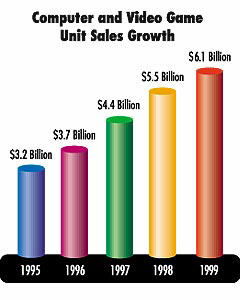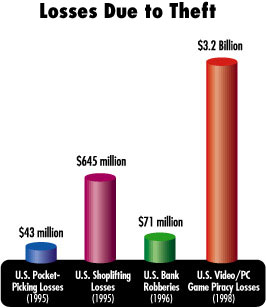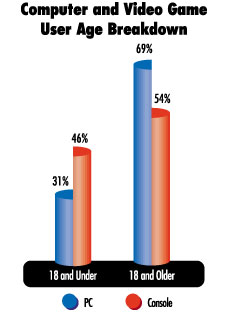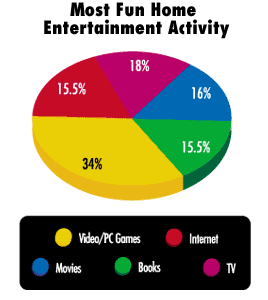LOS ANGELES—May
11, 2000 — Survey results released today by the
Interactive Digital Software Association (IDSA), the
trade group representing computer and video game
publishers, show that an overwhelming percentage of
computer and video game players play with friends and
family, confirming the view that interactive
entertainment brings people together and burying the myth
that games are not a social activity.
The results of the
IDSA’s fifth annual consumer survey, released today
at the Electronic Entertainment Expo, reveal that
fifty-nine percent of respondents play with friends, and
most play with a member or members of their family,
whether their siblings, spouses, a parent or extended
family. Thirty-three percent play with brothers and/or
sisters, 27 percent play with their spouse, 25 percent
play with their parents, and a whopping 43 percent play
with other family members.
“There are many
reasons why sixty percent of all Americans – or
about 145 million people – play computer and video
games, and the fact that they are a social activity is
chief among them,” said Douglas Lowenstein president
of the IDSA. “As home computers have become more
ubiquitous and consoles have spread into millions of new
homes, the user base has broadened to include Moms and
Dads, husbands and wives, brothers and sisters, friends
and neighbors. In short, everyone is playing computer and
video games, and they’re playing them
together.”
Indeed, the fact that
interactive games are a social activity that can be
enjoyed with family and friends was one of the top five
reasons (37 percent) that frequent users cited for liking
games. More than half also said that games are a great
stress reliever (55 percent). Other top reasons included
the fact that games are challenging (78 percent), they
provide a lot of entertainment value for the money (49
percent) and they are engrossing (39 percent).
Most Fun
Activity Three Years in a Row
The study also found that
for the third consecutive year, an astonishing 35 percent
of all Americans identified computer and video games as
the most fun entertainment activity. A distant second was
watching television (18 percent), then surfing the
Internet (15 percent), reading books (13 percent), going
out to the movies (11 percent), renting movies (6
percent) and lastly, pay-per-view television (0.5
percent).
Other Survey Highlights
Of the frequent users who
play computer games, 28 percent are under eighteen years
old, 30 percent are between 18 and 35 years old and 42
percent are over 35 years old. Of the frequent users who
play on video game consoles, 42 percent are under
eighteen years old, 37 percent are between 18 and 35
years old and 21 percent are over 35 years old.
Computer and video games
were predicted by frequent users to be a close second
behind the Internet as the most popular form of
entertainment in ten years. The Internet, including
Internet games, topped the list with 31 percent, computer
and video games with 28 percent, DVD/VCR movies with 21
percent, television with 11 percent, and movies in the
theatres, pay-per-view television, reading books and
audio CD’s all under 4 percent.
For the third consecutive
year, PC owners say they use their computers more for
playing games than for any other application, including
word processing, web-surfing, and email.
Ninety-seven percent of
all people who actually purchase computer games, and 87
percent of those who purchase video console games, are 18
years old or older. Of those under 18 who purchase
games, 84 percent say they get their parents permission
before doing so.
The annual survey was
conducted by the Custom Research Division of the NPD
Group for the IDSA. The study is the most in-depth and
targeted survey of its kind, gathering data from more
than 1,621 nationally representative households that have
been identified as owning either or both a video game
console or a personal computer used to run entertainment
software.
|
Other Information
Facts
Video/PC games
represent the fastest growing segment in the
entertainment industry.
The prevalence of
personal computers and video game consoles in American
society creates a growing market for PC, video and online
games.
IDSA’s
Online Gaming Attitude and Usage Study indicates
45 percent of U.S. homes have PCs, representing a
13 percent increase in household
penetration for the year. And, since
entertainment software is the number one
application used on all PCs, the growing
availability of brand-name computers costing less
than $1,000 will likely continue stimulate
interest in PC and online games.
More than half
of U.S. households will have PCs by the end
of the year 2000, expanding the potential market
for PC and online gaming.
Household
penetration of "next generation" game
consoles has grown from six million in 1996
to an estimated 25-30 million in U.S.
homes at the end of 1998, and is projected to
reach 35-40 million by the end of 1999.
What’s going to
happen next?
In a recent survey of
interactive entertainment industry CEOs, the IDSA found a
high degree of confidence in the continued growth of the
market.
Domestic Growth
How will gamers get
software in the future?
DVD-ROM is
predicted to have the biggest impact on the way
gamers receive software in the next two years,
selected by 65 percent of CEO respondents over
other interactive entertainment delivery systems
such as high-speed telephone download (13
percent), cable delivery (9 percent of
respondents), and set-top Internet box (4
percent).
All respondents
predict that consumers will continue to purchase
the overwhelming majority of software through traditional
retail outlets over the next five years,
rather than through the Internet.
Online gaming
continues to grow as an important part of
the interactive entertainment industry. One third
(32 percent) of Internet users — both game
players and non-players — now play games
online. Nearly half of online game players
(43 percent) say they have played online for
only one year or less, reflecting online
gaming’s relatively new audience and growth
potential.

The overall impact of
interactive games on the U.S. economy is staggering.
According to the
"Economic Impact of the Interactive
Entertainment/ Edutainment Software Industry
Report," conducted bi-annually by the IDSA
in association with Coopers & Lybrand L.L.P.
, the interactive entertainment industry
generated $16 billion in overall economic
activity in 1997, not including computer and
video game hardware sales.
Interactive
entertainment software industry directly
generated revenues of $5.5 billion in 1998 from
the sale of computer, video, and Internet games
and edutainment software. In addition, video game
rentals accounted for $800 million in revenue.
$1.3 billion was
generated by the licensing and distribution of
these products and through supplying original
equipment manufacturers.
$9.6 billion in
indirect economic impact in related industries,
such as packaging and printing, retail, talent
and equipment manufacturing, was generated.
Employment trends set
a standard for other industries.
The interactive
entertainment industry directly employs at
least 50,000 workers in the United States
and 17,000 more internationally.
In fact, the
industry's rapid growth helped create 20,000
new jobs in a variety of American businesses
last year alone.
In the past two
years, the expansion in the industry's work
force has topped 18 percent, compared to an
average decline of 2.5 percent in the work force
of Fortune 500 companies.
Investment spending on
research and development — the backbone of the
video/PC game industry — continues to pay off.
In 1998,
interactive entertainment businesses invested
approximately $2 billion in new technology research
and development, translating into an increase
in R&D spending of 20 percent by the
average company in 1997.
Entertainment
software companies' rate of productivity is
high and growing. The industry's growth in
revenues-per-employee ratio -- a measurement of
how effectively an industry utilizes its employee
base to generate sales -- was more than double
that of the average Fortune 500 company last
year.


STEALING: GAME OVER
— PIRACY STEALS BILLIONS OF DOLLARS FROM VIDEO GAME
AND PC GAME COMPANIES
Piracy cheats the
interactive entertainment industry and its customers.
The nations
and territories at the top of the video game
and PC game piracy list include: Greater China,
Russian Federation, Mexico and Hong Kong. Other
markets contributing to serious entertainment
software piracy are Thailand, Malaysia and
Paraguay.
Progress is being made
in the fight against piracy, thanks in part to IDSA
activities.
The IDSA has a
comprehensive year-round domestic anti-piracy
campaign, including education, enforcement and
policy work.
The IDSA
currently has anti-piracy programs on the ground
in Paraguay and Hong Kong, and will continue to
use its resources to ensure that worldwide piracy
is curtailed.

|
WHO’S PLAYING
GAMES? SURPRISE — IT’S NOT JUST WHO YOU THINK.
This isn’t a boys
club — women (and girls) are making interactive
entertainment part of their lives.
According to the
IDSA’s fourth annual Video and PC Game
Industry Trends Survey, more women are playing
games than ever. Thirty five percent of
console game players and more than 43 percent of
PC gamers are women, a slight increase over last
year.
Today’s video/PC
gamer is older, more educated and more affluent.
Contrary to
popular belief that video and PC games are only
for kids, nine out of 10 of all purchasers of
video game software are over 18 years of age,
suggesting that adults can control the games that
come into their homes using the ESRB rating
system as a guide.

Gamer satisfaction
tells the story — the quality of game play surpasses
both traditional and high-tech entertainment options.
Playing video/PC
games was the second most popular
entertainment activity among the most
frequent users of entertainment software,
according to the IDSA’s 1999 Video and PC
Game Industry Trends Survey.
Watching
television
Playing
video/PC games
Reading
books
Surfing
the Internet
Renting
videos
Going to
the movies
When asked to
rank the most fun entertainment activity,
frequent users put video/PC games at the top of
the list:
Playing
video/PC games (34 percent)
Watching
television (18 percent)
Going to the
movies (16 percent)
Surfing the
Internet (15.5 percent)
Reading books
(15.5 percent)
Entertainment
software is the number one application
used on PCs, followed by word processing
software, business/finance programs and online
activities.
What are the most
popular types of games?
Action (purchased
by 30.3 percent of PC users and 48.4 percent of
console users)
Sports (24.7
percent of PC users, 37.6 percent of console
users)
Puzzle/board/card
games (32.6
percent of PC users, 34.2 percent of console
users)
Most video/PC games
are appropriate for all ages.
ARE YOU ONLINE?
GAMERS ARE.

The boom of the
Internet has spawned an entirely new form of interactive
entertainment — online gaming.
According to
figures from the IDSA’s Online Gaming
Attitude and Usage Study, one-third of people
on the Internet now play online games regularly.
The most
surprising online gaming finding is the people
who are playing. Surprisingly, female gamers
are more likely than male gamers (53 percent
vs. 46 percent) to play games online
(though men are the majority of players of
traditional game genres such as action, role
playing and simulation games).
Male and
female online gamers prefer different types
of games, with female gamers preferring quiz,
trivia and contests games, while male gamers
select action games as their favorite type of
online game.
People who play
online games spend an average of three hours
per week playing games online and an average
of 5.4 hours per week playing offline games on
their PCs.
Online gaming is
in the early stages of a growth surge.
Forty-three percent of those playing online games
have been doing so for less than one year.
Online gamers
represent a segment of the video/PC game industry that is
affluent, educated and computer-savvy.
Online gamers are
an affluent and well-educated group.
Nearly 40 percent of online game players
have household incomes of $60,000 or more.
Eighty-eight percent of online gamers have
at least some college education and
17 percent have a post graduate degree.
The vast majority
of online gamers are adults. Seventy-nine
percent of online gamer are between the ages of
25-55, with 60 percent of these in the
25-44 year old age bracket.
|